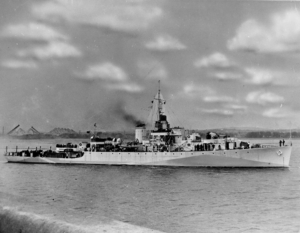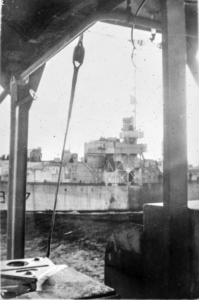OFFICIAL HISTORY OF

The “River” Class frigate HMCS KIRKLAND LAKE was laid down in the yards of the Morton Engineering and Dry Dock Co. at Quebec on 16 November 1943, launched on 27 April 1944 and commissioned on 21 August 1944. She was named in honour of the community of the same name in Timiskaming District, Ontario. This community is 160 miles north of North Bay and is the second largest gold-mining centre in the country. The lake, which once washed its shores, is now filled in. It was named after Winnie Kirkland, an employee of the provincial Department of Lands and Forests.
The frigate arrived in Halifax on 10 September 1944. Repairs kept her there until 20 November when she sailed for Bermuda to “work-up”. Back in Halifax in December, she left harbour on the 24th with HMC Ships TRANSCONA and CLAYOQUOT to take screening stations on Convoy XB-139. But first the three ships steamed abreast in an anti-submarine sweep. The sweep finished, KIRKLAND LAKE ordered her companions to join the convoy. CLAYOQUOT proceeded to do so when, at 1340Z, there was an explosion in her starboard quarter. It was not a violent one; indeed, but for the sudden list taken by the ship, it would have been scarcely noticed by those on the bridge. It was followed by a second explosion. Since both occurred at the stern of the ship, it appeared that she had been the victim of a “gnat” or acoustic torpedo which is attracted by the sound of a ship’s propellers.
 The second explosion spelled the end of the ship. About ten minutes after the first struck, she sank three miles off the Sambro Light Vessel. Eight men died in her. HMCS FENNEL picked up the survivors. KIRKLAND LAKE at the head of the group of ships, which had come out from harbour, led a search for the killer. The hunt proved to be unsuccessful, although the ships picked up a few contacts and an RCAF Liberator sighted a periscope. The ships, including KIRKLAND LAKE, pressed several attacks and the aircraft dropped depth charges. Photographs of the periscope confirmed the presence of a submarine.
The second explosion spelled the end of the ship. About ten minutes after the first struck, she sank three miles off the Sambro Light Vessel. Eight men died in her. HMCS FENNEL picked up the survivors. KIRKLAND LAKE at the head of the group of ships, which had come out from harbour, led a search for the killer. The hunt proved to be unsuccessful, although the ships picked up a few contacts and an RCAF Liberator sighted a periscope. The ships, including KIRKLAND LAKE, pressed several attacks and the aircraft dropped depth charges. Photographs of the periscope confirmed the presence of a submarine.
On 27 December KIRKLAND LAKE joined Escort Group 16, a support group of frigates, Senior Officer in HMCS SPRINGHILL. While the support group frequently reinforced the close escorts of convoys, its primary duty was to hunt out and, if possible, destroy U-boats. Because the enemy prowlers remained a menace in the immediate vicinity of British shores, the group sailed for Londonderry, Northern Ireland, in March 1945, where it served under the operational control of the Commander-in-Chief, Western Approaches. Not much was left of the war in Europe, but the underwater threat remained until all U-boats were accounted for, in early June. Among other duties, the group supported convoys to Cherbourg and Gibraltar. On 16 June the frigates were ordered to Greenock in Scotland to embark personnel from the naval base HMCS NIOBE for the return to Canada. In Halifax on 24 June, the group disbanded and, a few days later, KIRKLAND LAKE sailed for Morton’s in Quebec for a refit. She returned to Halifax in November. On 14 December 1945 she paid off into the reserve fleet.
Earlier plans had proposed the retention of KIRKLAND LAKE for the post-war navy, but it was decided to retain no frigates, and she was offered for sale by War Assets Corporation in 1947. She was sold in April of that year to the Halifax Shipyards Ltd. which passed her on to the Dominion Steel Corporation of Sydney, N.S., to be broken up.
Directorate of History
National Defence Headquarters
Ottawa, 15 November 1974

 CFB Esquimalt Naval and Military Museum
CFB Esquimalt Naval and Military Museum
 CFB Esquimalt Naval and Military Museum
CFB Esquimalt Naval and Military Museum CFB Esquimalt Naval and Military Museum
CFB Esquimalt Naval and Military Museum CFB Esquimalt Naval and Military Museum
CFB Esquimalt Naval and Military Museum CFB Esquimalt Naval and Military Museum
CFB Esquimalt Naval and Military Museum CFB Esquimalt Naval and Military Museum
CFB Esquimalt Naval and Military Museum CFB Esquimalt Naval and Military Museum
CFB Esquimalt Naval and Military Museum CFB Esquimalt Naval and Military Museum
CFB Esquimalt Naval and Military Museum CFB Esquimalt Naval and Military Museum
CFB Esquimalt Naval and Military Museum CFB Esquimalt Naval and Military Museum
CFB Esquimalt Naval and Military Museum CFB Esquimalt Naval and Military Museum
CFB Esquimalt Naval and Military Museum CFB Esquimalt Naval and Military Museum
CFB Esquimalt Naval and Military Museum
 CFB Esquimalt Naval and Military Museum
CFB Esquimalt Naval and Military Museum CFB Esquimalt Naval and Military Museum
CFB Esquimalt Naval and Military Museum CFB Esquimalt Naval and Military Museum
CFB Esquimalt Naval and Military Museum CFB Esquimalt Naval and Military Museum
CFB Esquimalt Naval and Military Museum CFB Esquimalt Naval and Military Museum
CFB Esquimalt Naval and Military Museum CFB Esquimalt Naval and Military Museum
CFB Esquimalt Naval and Military Museum CFB Esquimalt Naval and Military Museum
CFB Esquimalt Naval and Military Museum CFB Esquimalt Naval and Military Museum
CFB Esquimalt Naval and Military Museum CFB Esquimalt Naval and Military Museum
CFB Esquimalt Naval and Military Museum CFB Esquimalt Naval and Military Museum
CFB Esquimalt Naval and Military Museum

 CFB Esquimalt Naval and Military Museum
CFB Esquimalt Naval and Military Museum CFB Esquimalt Naval and Military Museum
CFB Esquimalt Naval and Military Museum CFB Esquimalt Naval and Military Museum
CFB Esquimalt Naval and Military Museum CFB Esquimalt Naval and Military Museum
CFB Esquimalt Naval and Military Museum CFB Esquimalt Naval and Military Museum
CFB Esquimalt Naval and Military Museum
 CFB Esquimalt Naval and Military Museum
CFB Esquimalt Naval and Military Museum



 CFB Esquimalt Naval and Military Museum
CFB Esquimalt Naval and Military Museum



































 CFB Esquimalt Naval and Military Museum
CFB Esquimalt Naval and Military Museum CFB Esquimalt Naval and Military Museum
CFB Esquimalt Naval and Military Museum
 CFB Esquimalt Naval and Military Museum
CFB Esquimalt Naval and Military Museum